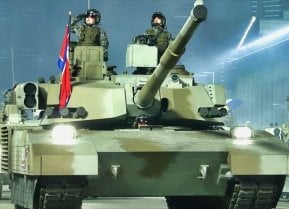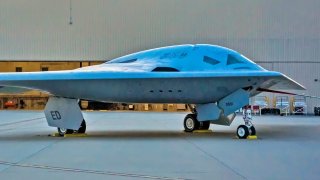The B-21 Raider Question: How Many Bombers?
Summary: The U.S. Air Force's B-21 Raider represents the next leap forward in strategic bomber technology, having taken its maiden flight in November of last year. As it moves through development towards becoming the backbone of the Air Force's long-range strike capabilities, questions about the total number of units to be produced remain open.
Summary: The U.S. Air Force's B-21 Raider represents the next leap forward in strategic bomber technology, having taken its maiden flight in November of last year. As it moves through development towards becoming the backbone of the Air Force's long-range strike capabilities, questions about the total number of units to be produced remain open. The initial plan for a minimum of 100 bombers aims to modernize and replace aging fleets, with a focus on countering emerging threats from near-peer adversaries like China.
The B-21 Raider's Uncertain Future: Balancing Cost and Capability
The U.S. Air Force's B-21 Raider took its maiden flight last November. While progress is being made on developing the future backbone of the Air Force's bomber fleet, there is still no solid consensus on how many of the long-range strategic bombers will be produced. A formal decision is unlikely to be made anytime soon.
"The decision point, with lead time accounted for, to go past 100 is not until the mid to late '30s," Lt. Gen. Richard G. Moore Jr. told lawmakers on the House Armed Services Committee on March 12.
"So the commitment right now is to 100 aircraft. That takes us for procurement into the late '30s," Moore added. "The decision whether or not to go past that may very well not be based on China, because it will be made at a time when we don't foresee the security environment and we don't need to."
As reported by Air & Space Forces magazine, the Air Force planned to acquire a minimum of 100 B-21 Raiders to replace its aging B-1B Lancers and B-2 Spirits. The Raider is set to operate alongside the even older B-52 Stratofortress until the late 2040s, and perhaps even beyond. However, officials at Air Force Global Strike Command have argued that the service needs more of the future stealth bombers to effectively counter near-peer adversaries, notably China.
In addition to the single B-21 currently being used for flight testing, at least five other prototype Raiders are in various stages of production. Those six will be dedicated to test activities, but after the developmental and operational testing has been completed, they will be modified into operational bombers.
B-21 Raider: From Six to 100 (or More)
It is unclear whether the Air Force will reach the minimum of 100 bombers requested by 2039. That will require annual production of six or seven bombers. The service hasn't disclosed how many aircraft are being produced throughout the Low-Rate Initial Production phase, which the bombers entered in January.
Aerospace firm Northrop Grumman was awarded the contract to produce the next-generation bomber in 2015, and the company quickly assembled a nationwide team to design, test, and build the B-21. The Raider – named for the 80 men who took part in the World War II Doolittle Raid on Tokyo in the spring of 1942 – was developed using the aerospace firm's digital engineering practices and advanced manufacturing techniques in tandem.
The testing aircraft are being built on the same lines, using the same tools and processes, that will build the eventual full-production aircraft. That approach was adopted to enable production engineers and technicians to capture lessons learned and apply them directly to follow-on aircraft, driving home a focus on repeatability, producibility, and quality.
Some 8,000 employees of Northrop Grumman and various other defense contractors of all sizes, spread across 40 states, have been secretly building the Air Force's new stealth bomber. Great efforts have been taken to prevent China and other potential adversaries from gaining access to its technology.
In addition to building a bomber with state-of-the-art technology and capabilities, Air Force officials have further emphasized the focus on containing costs while simultaneously allowing for maximum flexibility. The B-21 has been noted for being designed with an open systems architecture that would enable rapid integration of future capabilities to keep pace with the highly contested threat environment.
Yet, in addition to the Raider being the most advanced aircraft built to date, it could also be among the most expensive planes to ever fly, with each costing around $700 million. That could affect how many are built.
The Raider may also not be alone in the skies, as China could officially unveil its Xi'an H-20 to the public in the coming months.
Author Experience and Expertise: Peter Suciu
Peter Suciu is a Michigan-based writer. He has contributed to more than four dozen magazines, newspapers, and websites with over 3,200 published pieces over a twenty-year career in journalism. He regularly writes about military hardware, firearms history, cybersecurity, politics, and international affairs. Peter is also a Contributing Writer for Forbes and Clearance Jobs. You can follow him on Twitter: @PeterSuciu. You can email the author: [email protected].


